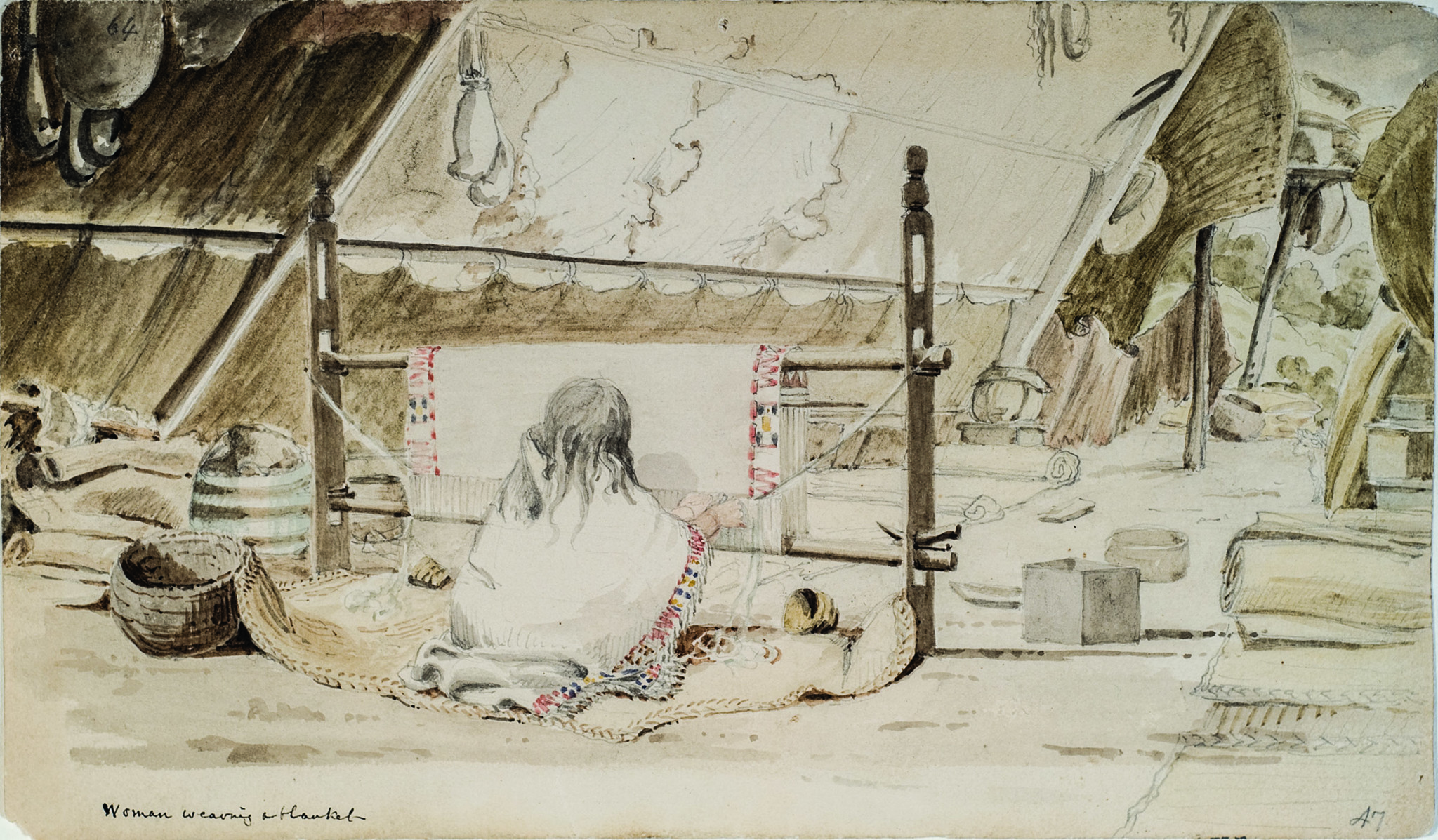Exhibition offers once-in-a-lifetime view of one of the world’s largest collections
of rare early blankets and contemporary Salish weavings
The Museum of Anthropology (MOA) at UBC with the Musqueam Indian Band present the inspiring and interactive new exhibition The Fabric of Our Land: Salish Weaving, on display from November 19, 2017 to April 15, 2018. Curated by MOA Curator Susan Rowley, in collaboration with Salish weavers, the exhibition will feature the historically significant, but relatively unknown, loom-weaving tradition of Salish peoples, showcasing one of the world’s largest collections of intricately designed blankets on loan from contemporary weavers, as well as museums in Europe and the eastern United States.
The exhibition is the result of a request from Musqueam Councillor and master weaver Wendy Grant John, who after viewing some of the weavings at the Smithsonian in Washington, DC was struck by their power to impart knowledge and inspiration to Salish weavers and the public. She has worked for more than 30 years to bring transformative change to Indigenous communities across the country and build stronger relationships between Aboriginal and non-Aboriginal people.
“The process of colonization took the same devastating toll on Salish weaving as it did on countless other Indigenous cultural practices,” said Rowley, MOA Curator. “Mass-produced Hudson Bay Company blankets replaced hand-woven creations, the reserve system constrained access to required resources, the Indian Act banned ceremonies where blankets played an integral role, and residential schools broke the intergenerational transmission of knowledge. The resilience and strength of amazing women have led to the revival of Salish weaving in different communities at different times.”
The Fabric of Our Land: Salish Weaving will take visitors on a journey through the past 200 years of Salish wool weaving from the early 1800s through to today’s vibrant Renaissance. Ten of the earliest known Salish weavings are showcased in the exhibition on loan from the National Museum of Finland, the Perth Museum (Scotland), the Pitt-Rivers Museum (England), the Harvard Peabody Museum, and the Smithsonian Institution’s National Museum of Natural History. These institutions acquired these treasures from early traders and explorers who removed them from their traditional territories. These territories encompass the Lower Mainland of British Columbia, southeastern Vancouver Island, the Sunshine Coast, the Fraser Canyon, and Puget Sound. These early works will be featured alongside five mountain goat wool blankets from MOA’s collection dating from the late 1800s and early 1900s. More than 20 weavings from the 1960s to present day – some from MOA’s collection and others on loan from contemporary weavers – will demonstrate the continuity of weaving despite colonization.
At various times throughout the run of the exhibition, Musqueam master weaver and educator Debra Sparrow will reactivate an old loom from MOA’s collection by weaving a new blanket. Visitors will also have the opportunity to further their understanding by learning through doing at several looms in the exhibition space.
“The Fabric of Our Land: Salish Weaving hopes to provide the public with an understanding and appreciation of the remarkable history of Salish weaving. Visitors will experience these textiles while learning about the resources required in their creation, the domesticated dogs used in their production, the spiritual and cultural significance of these robes, their role in the economy, as well as their power as symbols of family protection and wealth,” explained Rowley. “Today’s weavers demonstrate the ongoing power of this art form as an integral part of community life and as a symbol of contemporary vitality, creativity, and strength.”
About MOA (moa.ubc.ca)
The Museum of Anthropology (MOA) at the University of British Columbia (UBC) is world-renowned for its collections, research, teaching, public programs and community connections. Founded in 1949 in the basement of the Main Library at UBC, its mission is to inspire understanding of and respect for world arts and cultures. Today, Canada’s largest teaching museum is located in a spectacular building overlooking mountains and sea. MOA houses more than 42,000 ethnographic objects and 535,000 archaeological objects, including many that originate from Asia (about 40 percent of MOA’s collection) as well as from the Northwest Coast of British Columbia. The Koerner Gallery features one of Canada’s most important European ceramics collections, while MOA’s Multiversity Galleries provide public access to more than 10,000 objects from around the world. The Audain Gallery and the O’Brian Gallery, MOA’s temporary exhibition spaces, showcase travelling exhibits, as well as those developed in-house.
| LISTING INFORMATION | MOA presents The Fabric of Our Land: Salish Weaving |
| Dates: | November 19, 2017 to April 15, 2018 |
| Opening: | November 19, 2017 at 12pm |
| Address: | Museum of Anthropology University of British Columbia 6393 NW Marine Drive, Vancouver, BC |
| Website: | moa.ubc.ca |
Feature image:
Woman weaving a blanket at Songhees, Vancouver Island, 1847. Paul Kane (1810-1871). Interior of a Lodge with an Indian Woman Weaving a Blanket. Watercolour and pencil on paper. Bequest of H.J. Lutcher Stark, 1965. Stark Museum of Art, Orange, Texas, 31.78.73.

